Cite this document
(“Prevention of Falls in Elderly Rehabilitation Patients Essay”, n.d.)
Prevention of Falls in Elderly Rehabilitation Patients Essay. Retrieved from https://studentshare.org/miscellaneous/1517089-prevention-of-falls-in-elderly-rehabilitation-patients
Prevention of Falls in Elderly Rehabilitation Patients Essay. Retrieved from https://studentshare.org/miscellaneous/1517089-prevention-of-falls-in-elderly-rehabilitation-patients
(Prevention of Falls in Elderly Rehabilitation Patients Essay)
Prevention of Falls in Elderly Rehabilitation Patients Essay. https://studentshare.org/miscellaneous/1517089-prevention-of-falls-in-elderly-rehabilitation-patients.
Prevention of Falls in Elderly Rehabilitation Patients Essay. https://studentshare.org/miscellaneous/1517089-prevention-of-falls-in-elderly-rehabilitation-patients.
“Prevention of Falls in Elderly Rehabilitation Patients Essay”, n.d. https://studentshare.org/miscellaneous/1517089-prevention-of-falls-in-elderly-rehabilitation-patients.


